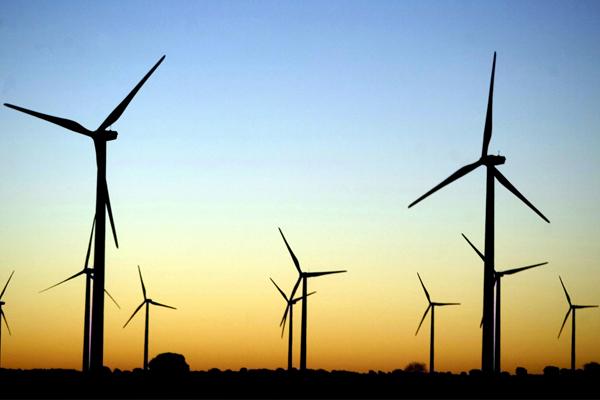
China is trying to ditch its coal addiction and reduce its energy intensity, find Chen Aizhu, Dominique Patton and Kathy Chen
China will boost efforts this year to rid itself of a strong addiction to coal in a bid to reduce damaging pollution as well as cut the energy intensity of its economy, which is expected to grow at its lowest rate in 25 years.
The National Development and Reform Commission (NDRC) said in its annual report on Mar. 5 that it would implement policies aimed at reducing coal consumption and controlling the number of energy-intensive projects in polluted regions.
China is trying to strike a balance between improving its environment and restructuring away from an economy dominated by energy intensive industries like steel making and construction towards one focused more on consumption and the service sector.
China's Premier Li Keqiang said the government planned to cut the country's energy intensity, the amount of energy used per unit of GDP growth, by 3.1 percent in 2015, compared with a 4.8 percent fall in 2014.
Li said the world's second-largest economy would target growth this year of around 7 percent, signaling the lowest expansion for a quarter of a century.
"This mark-down in growth and three quick monetary stimulus programs across the last four months reflects the state of slowdown China is in," said Howie Lee, analyst at Singapore-based brokerage Phillip Futures.
Premier Li made fighting pollution a priority. "We will strive for zero-growth in the consumption of coal in key areas of the country," he said to parliament.
"Environmental pollution is a blight on people's quality of life and a trouble that weighs on their hearts," Li said.
"For areas affected by severe smog, regions where conserving energy is difficult, and industries with overcapacity, we will strictly control the number of energy-intensive projects and implement policies for reducing coal use, and for replacing coal with alternative energy sources," the report said.
China's top energy official, Nur Bekri, said in comments published by the National Energy Administration that improving efficiency and environmental standards for coal would be a key component of China's energy policy this year.
He said the country would aim to raise wind power capacity to 200 gigawatts (GW) and solar to around 100 GW by 2020, up from 95.8 GW and 26.5 GW respectively at the end of 2014.
China is also aiming to raise natural gas output to more than 245 billion cubic meters a year by 2020, up from 161.6 bcm in 2013.
China plans to cap coal use to below 65 percent of total primary energy consumption by 2017 and move towards 50 percent by the middle of the century. The government wants natural gas and renewables to take up most of share lost by coal.
PRICE IMPACT
As the world's biggest consumer of energy and raw materials, China's slowing growth and restructuring is having a big impact on commodities markets.
Brent crude oil prices have fallen by around 50 percent since June 2014 as rising global production clashes with slowing economies, especially in Asia, as well as improving energy efficiency.
Iron ore prices, used for steel making, are hovering close to levels last seen during the financial crisis in 2008/2009, and thermal coal, the main power generation fuel, is close to 10-year lows.
Almost 70 percent of China's total energy needs currently come from coal, compared with developed economies like the United States, Japan or Germany, where oil is the biggest energy source. In China, oil contributes less than 20 percent.
Both are seen as dirty compared with gas, the third most used fossil fuel, or alternative fuels such as nuclear power or renewables.
Back to topChina's new oil import policy positive for quality, prices: governor
By Chen Aizhu
China's decision to allow more independent oil refiners to import crude oil will help to improve fuel quality and lower domestic fuel prices, the governor of Shandong province, the country's hub of small refineries, said.
China, the world's second biggest crude importer after the United States, has had strict controls on oil imports to ensure stable domestic supplies. State-controlled companies Sinopec and PetroChina account for nearly 90 percent of the country's inbound crude shipments.
But in February, Beijing took advantage of a global oil price collapse to loosen the tightly controlled sector, which will allow smaller refiners to apply for crude oil import quotas.
"This new policy breaks the previous situation that only three to four big companies are allowed to import crude oil," Guo Shuqing, governor of the eastern province told reporters on Mar.7 during an annual parliament meeting.
Shandong is home to most of China's so-called swing refining capacity, estimated by industry experts at roughly 20 percent of the country's total.
These small plants, often backed by local governments or privately owned, have for years been excluded from direct access to crude oil, let alone foreign supplies. Instead, they have been processing fuel oil, a heavy refined fuel that is normally dirtier than crude oil.
"It (the policy) may help improve fuel quality, clean up the air and also lower the fuel prices consumers pay," Guo said.
Shandong has about 100 million tonnes of oil refining capacity (roughly 2 million barrels per day), but throughout last year was only about 50 million tonnes, Guo said.
That would be equivalent to about a 50 percent utilization ratio, significantly below the big state refiners' average operation of 80 percent or above.
Under the new rule, refiners with a minimum annual crude refining capacity of 40,000-bpd would need to demolish outdated refining facilities in exchange for being able to apply for crude oil imports.
Guo said he considered it was achievable for Shandong plants to remove up to 20 million tonnes annual capacity, or 400,000 bpd.
He also said local authorities would be ruthless in closing down petrol stations that sell sub-quality fuels. Last year, in the city of Heze alone, more than 200 gas kiosks were forced to shut for that reason.
Guo, formerly a state bank executive and head of the country's securities watchdog, has been seen by the oil industry as a strong backer for Beijing's plan to launch Shanghai crude oil futures.
Oil traders have said that a loosening of the oil import rules could provide the liquidity needed to ensure the success of an oil futures contract.
Guo also said Shandong would slow down the process of adding new coal-fired power plants in the province and use more clean coal. Coal fuels some 80 percent of Shandong's power generation.
Back to topChina holds some hope for LNG producers
By Clyde Russell, Reuters columnist
Can China ride to the rescue of producers of liquefied natural gas (LNG), who are bringing on stream ever more supply at a time when prices in Asia have sunk to 4-1/2 year lows?
The world's largest commodity consumer has taken some of the blame for the plunge in the spot price LNG-AS, which dropped to $7.20 per million British thermal units (mmBtu) in February, the lowest since July 2010 and down almost 65 percent from the same time last year.
To be sure, a warmer than usual winter in North Asia and a well-supplied market are also major culprits in LNG's weakness.
But China's demand growth in 2014 didn't come anywhere near to meeting expectations.
LNG imports rose 10.3 percent to 19.85 million tonnes last year, a pace of growth that was less than half of what was achieved in 2013.
Slower economic growth and higher natural gas prices crimped demand for the cleaner-burning fuel, even as China tried to limit the use of coal in a bid to lower pollution.
China's natural gas demand grew by 5.6 percent last year to 178.6 billion cubic metres (bcm), which is less than half the average annual growth rate of 11.7 percent between 1995 and 2009.
Of that demand, 127.9 bcm was produced domestically, while 57.8 bcm was imported by pipeline or as LNG. The split between the two was in favour of pipeline, but not by too large a margin, with LNG imports amounting to almost 27 bcm.
There is little doubt that China's natural gas demand can return to double-digit growth figures, but much will depend on the actions of policymakers.
The authorities will have to continue a policy of trying to shift away from coal, and in doing so will have to actively encourage the use of natural gas.
In practical terms this means that they will have to reverse last year's price increases for natural gas, to allow the dramatic fall in LNG prices to be felt by both industrial and residential consumers.
The price hike in September last year raised the natural gas price in Tier 1 users to $10.70 per mmBtu and $12.80 for Tier 2, according to calculations by consultants FGE.
The two-tier system of pricing is scheduled to be scrapped this year, proving policymakers with a ready-made opportunity to lower natural gas prices in order to boost demand.
This will be essential if China is to meet its target of increasing natural gas use to 400 bcm per year by 2020, which would be more than double last year's consumption.
LNG TO COMPETE WITH PIPELINES
The sharp fall in LNG prices may help make the super-chilled fuel more viable against pipeline imports from other countries.
The problem for LNG has always been that it was too expensive compared to alternatives, but the tables appear to have turned.
China buys much of its pipeline gas on oil-linked contracts, which means prices are currently falling given crude has more than halved since June last year.
This doesn't sound positive for LNG, but it may be insofar as it makes future pipeline projects considerably less viable.
The massive 38 bcm a year deal between China and Russia, signed last year, and due to start in 2018 may be a case in point.
While pricing for the deal was never publicly revealed, it was believed to be about the equivalent of $10 per mmBtu, delivered at the Chinese border.
With oil-linked pricing, this may have dropped to around $8 per mmBtu. Add to this the cost of transporting the gas from the border in the northwest to the main markets in the northeast, and the price will be closer to $12 per mmBtu.
This is well below the current spot price of LNG, meaning there is the potential for LNG to take market share from pipeline gas.
Additionally there is the increasing likelihood that some of the planned pipeline additions from Russia and Central Asia to China won't be built, or will be delayed, given the deterioration in the economics.
This gives LNG producers a chance to increase their penetration of the Chinese market, and also holds out some hope that the wave of new LNG from nearly-completed projects in Australia will find buyers for the uncontracted portions of their output.
About 32 million tonnes per annum of LNG capacity is likely to be commissioned this year from three Australian projects, with three more to come in the following years, as well as at least three new ventures in the United States.
Of course, the caveat is that LNG prices will have to remain low enough to compete with pipeline supplies, and also coal, while China's policymakers will also have to play their part.
Back to top


